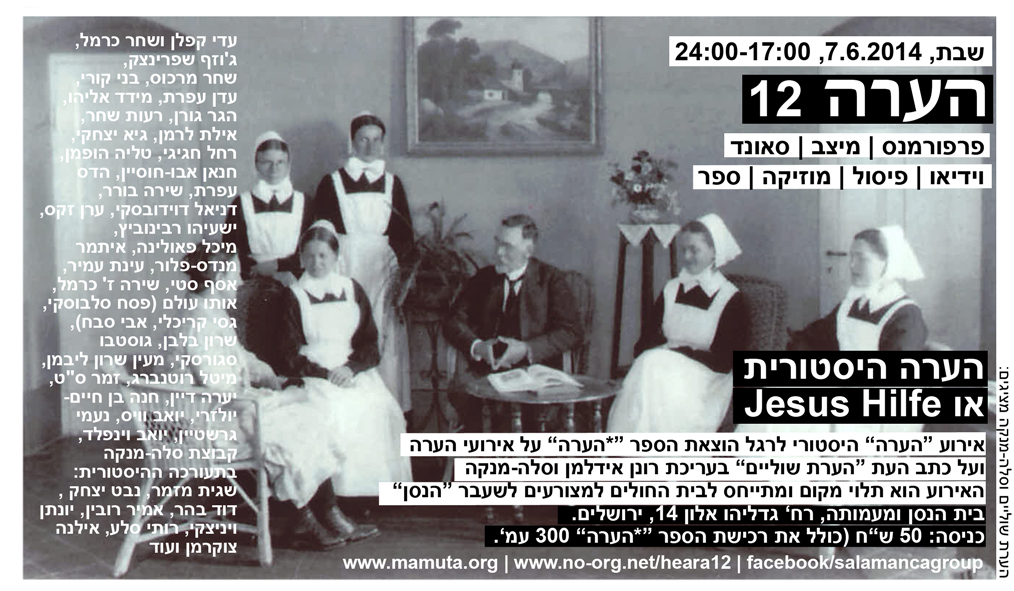Heara 12 - Historical Comment
Jun 07 2014
Hansen House, Mamuta Art and Media Center
Heara 12 - Historical Comment
Hansen House, Mamuta Art and Media Center
Jun 07, 17:00 - Jun 07, 23:55

בשבת 7 ביוני יתקיים בבית החולים למצורעים לשעבר "Jesus Hilfe" (בית הנסן) אירוע אמנות עצמאי שיימשך יום אחד בלבד (!) בהשתתפותם של יותר מ-50 אמנים מתחומים שונים (פרפורמנס, וידיאו, מיצב, מיצג, מוזיקה, אמנות סאונד, צילום וכו') אשר יציגו ביותר מ-1,500 מטר בחללי בית החולים לשעבר.
באירוע יוצגו עבודות חדשות שנוצרו לרגל האירוע ועוסקות בשני נושאים מרכזיים: בית החולים "Jesus Hilfe" (בית המצורעים לשעבר ובית הנסן היום) על מגוון היבטיו ההיסטוריים, הסוציולוגיים, הפוליטיים והאדריכליים; אירועי "הערה" וכתב העת "הערת שוליים" לאמנות עכשווית, שעיצבו, חידשו ואתגרו את הדרכים שבהן ניתן לקיים עשייה אמנותית באחת הערים הטעונות בעולם, מתוך התייחסות להיסטוריה ולהווה שלה ולמבניה האיקוניים, ויצרו קהילה אמנותית פורה בירושלים ומחוץ לה.
.
באירוע יושק הספר "*הערה" (כ-300 עמודים, צבע) בעריכתם של רונן אידלמן וקבוצת סלה-מנקה. הספר בוחן ומסכם את אחת התופעות המרכזיות שהתרחשו בירושלים מאז שנת 2000 לטענת אמנים, אוצרים ומבקרי אמנות רבים לאורך השנים.
The Hansen Compound was built by the Protestant community in Jerusalem in 1887 as a leprosy asylum. Planned by Conrad Schick, a member of the protestant community and one of the prominent architects working in Jerusalem in the 19th century, it has served its original purpose for over a century.
The walled compound was erected at a distance from the old-city's walls, at a site which at the time was far-removed and secluded. Over the years, as Jerusalem expanded beyond its historic walls, the hospital gradually came to be surrounded by residential neighborhoods. It's aura of mystery, however, subsisted. Often rumored to be a 'closed institution', its doors were in fact open, allowing both incoming visits from friends and family and the free exit of patients.
The hospital was designed to be self-sufficient, with a sizable produce garden as well as a pen and a cowshed on its very grounds. These were attended to by the inmates and hospital staff. Hence fruits, vegetables, drinking water, milk and wool were readily available. Cows and sheep grazed on the nearby hill, where the Jerusalem Theater currently stands.
Originally named 'Jesus Hilfe' (the name is engraved above the main entrance), it later came to be known as 'the leper home'. In 1950 the hospital was sold to the Jewish National Fund and placed under the management of Israel's Health Ministry. It was renamed 'the Hansen Governmental Hospital', after the Norwegian physician who identified the leprosy bacterium. In the second half of the 20th century, as antibiotic treatment grew more efficient, patients were gradually being discharged. Since 2000 the hospital no longer admitted patients for hospitalization, operating solely as an ambulatory clinic until its definite closure, in 2009.
Located at the Talbiya neighborhood, the edifice has been declared a listed monument due to its historic and architectonic value. Following its closure the building was entrusted in the hands of the Jerusalem Municipality, which has been put in charge of its restoration and consequent reopening as a cultural center. Planning and restoration works have been carried out through 2011–2013, headed by the Jerusalem Development Fund in cooperation with the municipality and the Jewish National Fund, with additional funding from the Ministry of Jerusalem and Diaspora Affairs.
The establishment has been reopened as a center for art, design and technology. The Mamuta Art and Media Center, an auditorium, a historical exhibit, interactive and new media installations, a 'fabrication lab' and Bezalel second degree on design.
